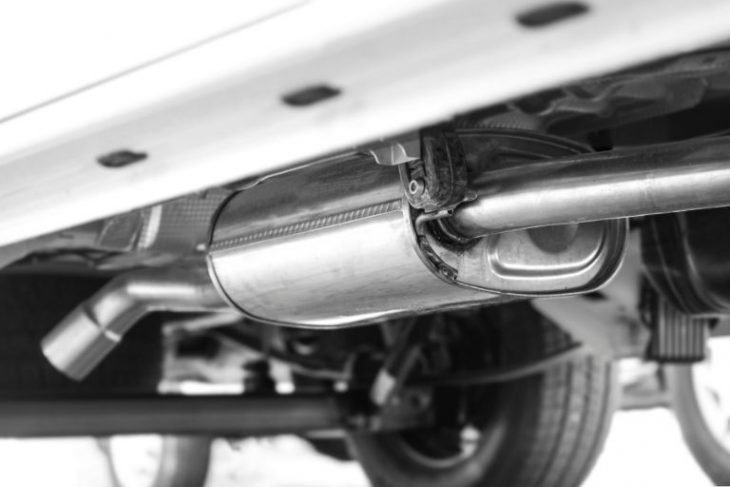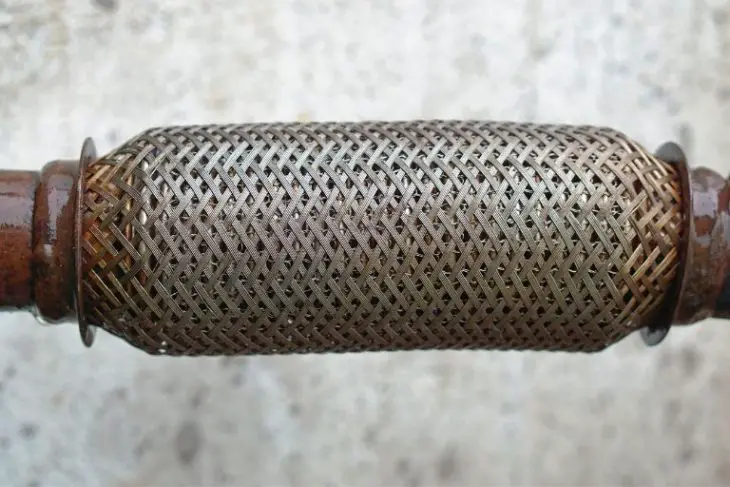After having driven your car for hundreds of thousands of miles, you might start noticing some odd symptoms. Maybe the check engine light comes on, you notice the engine doesn’t perform as it once did, and you hear a horrible rattling from underneath the vehicle. In case you didn’t know, that rattling is coming from your catalytic converter, which is one of the most expensive pieces of a vehicle to replace.
Fortunately, there are ways to stop catalytic converters from rattling. That is why we are going to teach you how to figure out the cause of the rattling and also give you some quick and easy fixes. Let’s begin.

Table of Contents
- What Noise Does a Bad Catalytic Converter Make?
- Causes of a Rattling Catalytic Converter
- Signs of a Bad Catalytic Converter
- How to Quiet Catalytic Converter Rattles
- Final Thoughts on Rattling Catalytic Converters
What Noise Does a Bad Catalytic Converter Make?

There are two characteristic sounds of a failing catalytic converter. Within the converter, the catalysts will function without pause for many, many years. When the wear and tear get to be too much, or there is a buildup of oil, the catalytic converter may struggle or fail. You will hear the result of that malfunction very clearly.
Rattling
Do you hear a rattling sound that is emitted from the bottom of the vehicle? Sometimes, it may even sound like the rattling comes from the engine. When it’s cold outside, the catalytic converter might make noise. Once the optimal temperature is reached, the rattling will fade away.
Knocking or Ticking
Several issues can cause a ticking or knocking. You might hear ticking when a vehicle is idling. In this case, you may not have an issue at all. Yet, if the sound gets louder whenever you accelerate, it could be caused by an exhaust leak.
Causes of a Rattling Catalytic Converter
The rattle doesn’t always mean certain doom for your catalytic converter. There are a couple of reasons a catalytic converter could be making a lot of noise.
Honeycomb Structure Breaking Apart
When you accelerate, does it sound like you’re shaking a jar of dried beans or sucking up sand with a vacuum? That is likely caused by a structure in your catalytic converter that looks a little like a honeycomb. When the ceramic honeycomb is worn down or has been damaged, it could end up causing a rattling sound.
The honeycomb isn’t always repairable. The good news is that you can stop the rattling easily. Using a hammer, tap on the converter until you find the source of the rattle. Insert a small screw into that spot. The screw will hold the loosened section in place. It is a temporary solution, but you’ll be able to go a little further with your current converter.
Loosened Heat Shield
A rattling heat shield is another common cause of a noisy catalytic converter. Over time, the bolts that hold the heat shield in place will corrode, loosen, or break. When that happens, the heat shield will move and rattle.
You could remove the heat shield entirely, but that will allow excessive heat to build up inside your car. There is also a chance of fire should you drive over litter, leaves, or grass.
Signs of a Bad Catalytic Converter
Sometimes, the issue with your catalytic converter is not so easily identified. You will have to consider the symptoms your vehicle is experiencing.
1. Sulfur Scent
Ever notice how a failing converter will produce a rotten egg smell? Or how the exhaust belches black smoke? That is the result of the sulfur dioxide that is produced during the combustion of hydrogen sulfide in the engine. Should the catalytic converter be failing, the gas won’t convert completely.
2. Check Engine Light
This is a common symptom of a failing catalytic converter. The sensors in the car will pick up something wrong with the catalytic converter and switch the warning light on. How does the car know? Thank the oxygen and air-fuel ratio sensor, which is built to measure the amount of gas in the exhaust system. When the gas isn’t catalyzed correctly, the sensor switches on the light.
Of course, there are multiple reasons why the Check Engine light will switch on. The best way to diagnose the cause is to take your car to a repair shop.
3. Poor Engine Performance
The catalytic converter is part of the exhaust system. In other words, it plays directly in how well your car operates. When the catalytic converter is cracked, loose, or clogged, the engine is going to struggle. You will notice less acceleration and power, a higher, rougher idle, and even periods when the car won’t start.
4. Rattling Noise
The telltale symptom of a bad catalytic converter is the rattle. The sound is most pronounced during start-up but may worsen with time.
Rattling, as mentioned earlier, is often caused by damage to the converter or the honeycomb mesh.
5. Failed Emissions Test
Because the catalytic converter is also responsible for removing any pollutants from your exhaust, you will need one that is functioning properly to get through a vehicle emissions test. However, a malfunctioning unit will usually cause your car to fail the test. However, this also means the technician will tell you what the problem is, so you at least know your catalytic converter is struggling.
6. Bad Gas Mileage
When your engine is performing poorly, it will also affect your gas mileage. If you feel like you’re filling up the gas tank more often, consider a clogged or failing catalytic converter.
How to Quiet Catalytic Converter Rattles

Quieting a noisy catalytic converter can be rather expensive. That said, you may be able to spare yourself the added expense by testing out some remedies. Doing so may increase the lifespan of the catalytic converter. Here are some ways to quiet a rattling catalytic converter:
1. Clean The Catalytic Converter
One of the simplest and most straightforward methods for quieting a rattling catalytic converter is to keep it clean. A buildup within the catalytic converter could cause noise, poor performance, and decreased gas mileage. Use one of the methods below to clean the converter and give it a new breath of life:
- Lacquer Thinner
Add a gallon of lacquer thinner to a 10-gallon gas tank. The chemicals in lacquer thinner are highly effective at removing some of the grime from your catalytic converter. After adding the solution to the gas, take your car out for a drive. Go for about 150 miles, keeping the RPMs at least 2,500 for half an hour. That is usually a sufficient amount of time for the lacquer thinner to run through the system and improve performance.
- Sodium Hydroxide
To clean your catalytic converter, you need to first take it out of the vehicle. Pour some sodium hydroxide into a spray bottle then soak the inside of the unit. Spray the catalytic converter inside on both sides to make sure everything is covered.
Leave the catalytic converter for about 20-25 minutes, letting the sodium hydroxide work on the grime. Once the converter has sat for long enough, rinse it out with a hose. Be sure to wash out both sides completely.
2. Fix the Heat Shield
If you’ve determined that the heat shield is the reason behind your rattling catalytic converter, you have the option to repair it. First, you will need to remove the old one. Loosen the bolts. You may need penetrating oil for the heat shield and bolts to remove the piece without issue.
Once you have removed the heat shield, wash the converter with soapy water. Check the interior. Any haziness can be smoothed down with sandpaper. Before installing the new heat shield, rub the bolts with an anti-seize compound. Tighten the bolts according to torque specifications.
3. High Octane Fuel and Additives
Though it might seem a bit too good to be true, you can clean out the catalytic converter as easily as using a higher grade of gasoline. If you are usually purchasing the lowest grade or low octane, you might want to try going for a more premium one. Use some fuel additives once in a while to clean out the converter as well.
Sometimes, that will be enough to help with airflow through the converter and halt the rattling.
4. Replace Your Cat
Theoretically, a catalytic converter should last the entire lifetime of the vehicle, but plenty of factors could lead to the catalytic converter clogging or failing. Even misfiring cylinders could cause overheating in the converter.
Sometimes, no matter what else you do, it will come down to replacing the catalytic converter. The cost, however, will be very high. Should the cost not be an issue, this is the best fix. Make sure you are purchasing the direct fit converter made for your specific car model, not a universal one. The universal catalytic converter requires welding. A vehicle-specific one only needs to be bolted in place.
Since this doesn’t require any major tools or much knowledge, you can often replace the catalytic converter on your own. Set the unit in place. Add some anti-seize to each bolt before putting them in their proper place. Tighten according to the correct torque specification.
Final Thoughts on Rattling Catalytic Converters
Since the catalytic converter is such an expensive piece of equipment, you probably wince every time you hear it start to rattle or knock. Fortunately, there are steps you can take to lessen the rattling and give new life to your cat. If cleaning the converter and using better quality gas doesn’t improve performance, however, you may have to spring for a new one.
But there is no harm in cleaning your catalytic converter in the meantime!
Recommended Reading
What Causes a Rattle in Muffler and How to Fix it?
Exhaust problems are common. When you are driving around, one situation you never want to encounter is hearing strange noises underneath your vehicle. Should...
Why is My Car Making a Rattling Noise When at Idle?
Whenever you hear your car making a rattling noise when at idle it is always a gamble. A 50/50 chance of either being a simple fix or an expensive replacement.
What does an Exhaust Leak sound like and How to fix it?
Since motor vehicles are made up of many parts, it's only natural that along the way some of them begin to experience problems. One of the most common areas...
What is an acoustic windshield?
An acoustic windshield is just like a regular windshield, with the added benefit of blocking outside sounds from coming into the cabin.
Why does my engine rattle on startup?
When you get into your vehicle and turn on the ignition, you want to hear your vehicle's engine purring like a kitten. Unfortunately, it may decide to sound...
How Long Will a Wheel Bearing Last After it Starts Making Noise
Vehicles need a good set of tires to keep them performing optimally. But there is more to the wheel than the tire; beyond the visible rubber is an intricate...